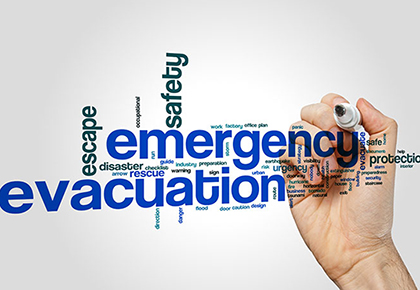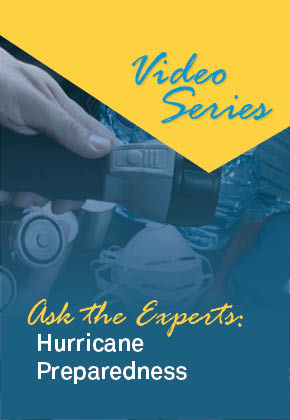 Whether you live in a Tampa high-rise, a Jacksonville gated community or an active adult property in Delray Beach, you know that hurricanes are a real risk. Hurricane Irma in September 2017 proved that, in a large enough storm, the entire state of Florida can be impacted by a hurricane.
Whether you live in a Tampa high-rise, a Jacksonville gated community or an active adult property in Delray Beach, you know that hurricanes are a real risk. Hurricane Irma in September 2017 proved that, in a large enough storm, the entire state of Florida can be impacted by a hurricane.
Do you think your residents would know where to go or whom to contact in an emergency situation? Does your onsite staff know what to do to protect residents and the community’s property in the event of a hurricane?
What about your vendors? Do they know what your community association expects of them before, during and after an emergency?
The strongest hurricane preparedness plan won’t be very effective if you haven’t communicated it to residents or if staff and vendors don’t know their role. The ensuing chaos that might occur in the face of an emergency could needlessly put people’s lives at risk.
Your property could also incur more damage than it would otherwise, which could hurt the community’s financial wellbeing and impact property values. Additionally, insurance claims could be denied or your premiums could go up if untrained staff or vendors didn’t take appropriate steps, such as protecting windows before a hurricane.
Make sure that everyone knows what to do by following these important recommendations.
Communicate about hurricane preparedness well before the season arrives.
Communicating your emergency preparedness plan with community residents once or using just one communication channel isn’t enough. People may overlook an email, forget what they were told or be new to the area and facing their first hurricane season. Reiterate your plan at regular intervals on your community website, in your newsletter, by email and during association meetings. If your area is prone to seasonal storms, remind residents of your emergency preparedness plan and what they should do well in advance of the season.
If your community has policies that are specific to hurricanes and tropical storms, such as when residents are permitted to put up shutters and when they must be taken down, when items must be secured outdoors, etc., make sure to reinforce those policies whenever you communicate about hurricane preparedness.
Don’t forget about your seasonal residents! If you have policies in place about what seasonal residents need to do to secure their properties before they leave, make sure that those are communicated in February, before the exodus typically begins. Take extra care to make sure that those absentee owners are included in every aspect of storm-related communication; the distance only increases their anxiety about what might happen to their property.
Have a system for communicating before the storm arrives.
When an actual emergency occurs, it is especially critical that your community has a reliable communication system in place, like FirstService Residential Connect, which has a mass communication tool that can reach your entire community in moments. Residents can be alerted by email and phone calls, as well as texts if they so choose. Encourage residents to opt-in for text messages! When other forms of communication can’t get through, sometimes texts still can.
Share critical information with your community, including pre-storm plans, storm procedures, disaster relief information, shelter locations and hours, evacuation routes, emergency response numbers, information on shut downs of major building systems and, for those owners with special needs, the Municipal Vulnerable Persons registry. This information should also include tips on how to storm-ready their units, as well as information that will help them navigate the insurance process afterwards, such as saving all receipts for expenses paid in the aftermath of the storm. You’ll also want to let residents know that management will be entering their premises if units need to be drained or dried.
“During Hurricane Irma, I found that it’s important to see who is staying behind at the property and if they are okay with management checking in with them regarding the status of the community,” says May Mokdad, regional director at FirstService Residential. “This helped us prepare for after the storm.”
Ensure each staff member knows their supervisor’s phone numbers and when they should report back to work following a storm. All employees should have identification that confirms they are employed by your association to allow them to get past potential checkpoints set up by authorities following a storm.
Keep communication flowing as the storm hits.
As long as possible, continue to communicate with residents. That mass communication system mentioned above allows that to be done quickly and easily. Even if individuals can’t get the messages when they’re sent, seeing them later will build goodwill by letting them know that their board cared to communicate.
That includes communication between the board and management, too. “At one property, the generator exhaust fan broke because of the winds and we lined the generator company up to come out as soon as the winds subsided enough to do so safely. Of course, the fire alarm went off when the exhaust fan broke and the fumes from the generator set off the fire alarm. This happened right in the middle of the storm!” Mokdad relates. “The fire alarm was going off and because I had a copy of the maintenance manual handy, I was able to talk one of the board members through how to reset the alarm from Orlando, even sending him screenshots of what the indicator lights should look like. We also called the fire alarm monitoring company and gave them a heads up on the situation so they didn’t dispatch the fire department when the storm passed.” To facilitate communication during a storm, Mokdad recommends that all appropriate people have a community binder that includes paper copies of the employee contact list, vendor list, maintenance manuals and documentation for major systems, insurance policies and contacts, current resident roster with their emergency contacts and indications of which residents will need help during an emergency.
Know you can count on your management company after the storm.
The same mass communication system you used before the storm will enable you and your management team to send email, text messages or phone calls en masse with important information and warnings. The system is also invaluable post-storm, because some forms of communication can be received and delivered when others cannot due to storm damage. If you can’t communicate through electronic devices, post paper notices in as many places as you can throughout the community or building. Don’t forget to include seasonal residents in all digital communications!
- Information should be provided to all residents including:
- Critical warnings, e.g. if drinking water needs to be boiled or if the elevator is out of service
- Frequent updates about what the board and management company are doing to clean up, repair and rebuild
- Other helpful resources, i.e. waste management contact information, and location information for operational gas stations and grocery stores
- Once electricity, phones and internet service are restored, make use of digital communications – email, community website, social media, online newsletters, and resident alert system – to deliver immediate, urgent information to your community.
- Rely on your property management company’s 24/7 customer service center to report and resolve any issues or emergencies. “As Hurricane Irma approached, we arranged for another FirstService Residential customer service center, across the continent, to handle all customer service calls for our customers in the Southeast,” says Stephanie Parker, vice president of strategy and operations for FirstService Residential. “Having that resource available meant that, even while local offices were without power, our customers were still taken care of.”
A great management company will update the board at least daily on the progress of cleanup and repair work as well as any important updates within the community. “FirstService Residential’s crisis team created an easy-to-use template for community association managers to use in updating residents about cleanup and recovery efforts,” Parker explains. “Communities were provided with information about what happened that day, what was anticipated for the following day and the status of the community, including critical information like grocery stores open nearby.”
Don’t forget your vendors.
Your trusted vendors need to know what you expect of them before, during and after an emergency. Conversely, your board needs to be aware of what your vendors are capable of and what resources they have available to keep your community safe. Discuss your emergency expectations with your vendors, and plan to meet with landscapers, roofers and other contractors prior to storm season. Make sure that your landscaper has a seasonal protocol for the extra tree trimming that should be done during hurricane season. “We were able to give the landscaper a heads up that they would be needed at a particular property immediately after the storm,” Mokdad says.
Find out if your vendors are located in mandatory evacuation zones. No matter their intentions or contractual obligations, your vendors will not be able to help your community if they’ve been ordered to evacuate. If that’s the case, it’s important to have those conversations ahead of time. Is there anything they can do to help you if a storm is approaching, perhaps early delivery of supplies or materials you would need after a storm? Is there a backup vendor or a partner they can recommend that isn’t located in a mandatory evacuation zone?
Your community needs to have an actionable emergency preparedness plan in place, but it’s just as important to effectively communicate that plan and train everyone on their roles in it. This will minimize your association’s risk and increase resident safety, as well as maintain the financial health of the community.

Watch the full video
Is your community association prepared for hurricane season? Access our Hurricane Preparedness video.
Watch now